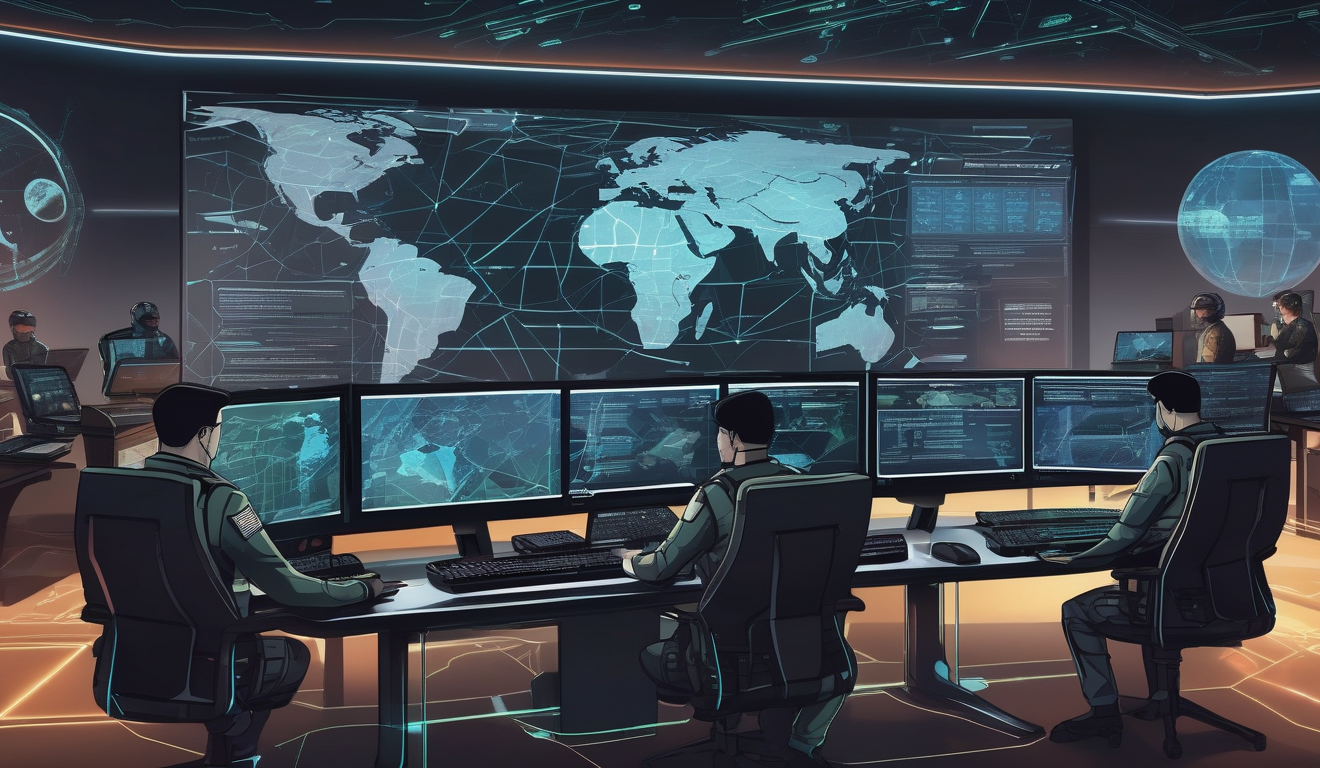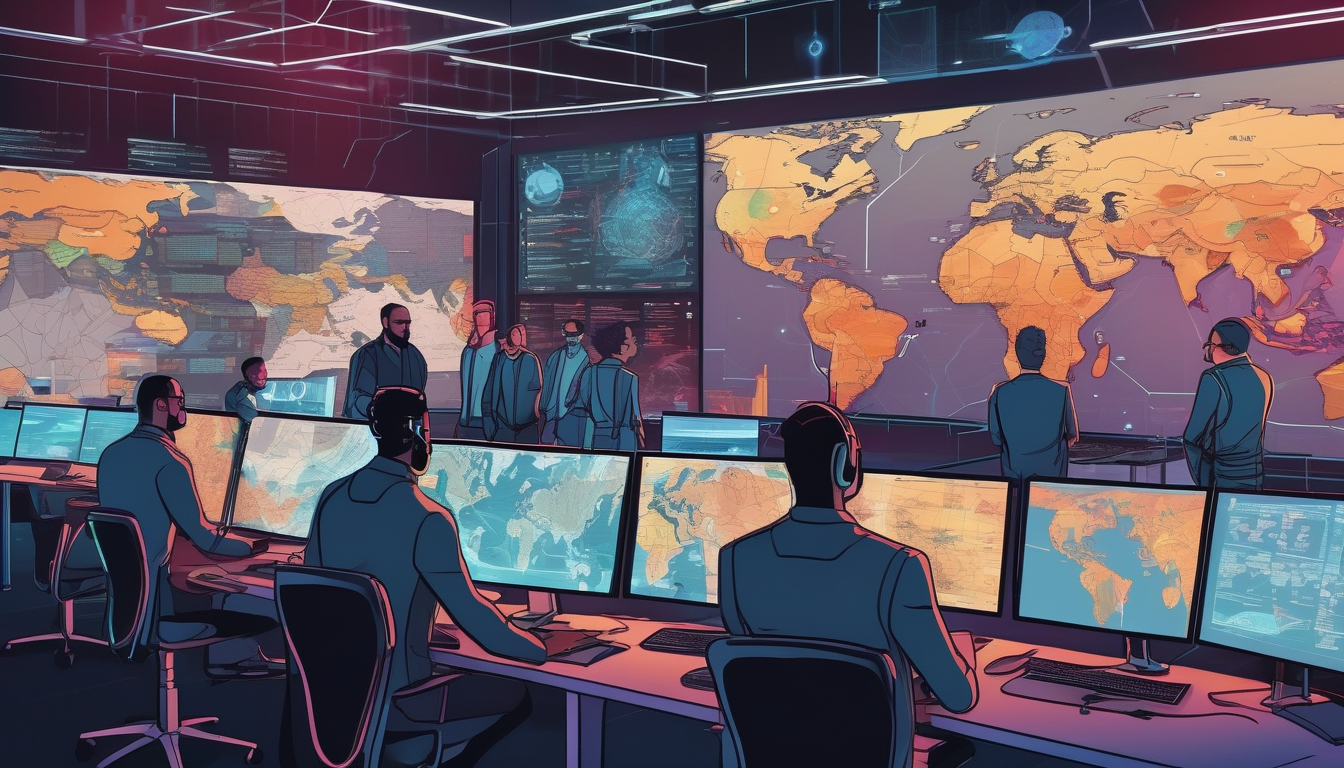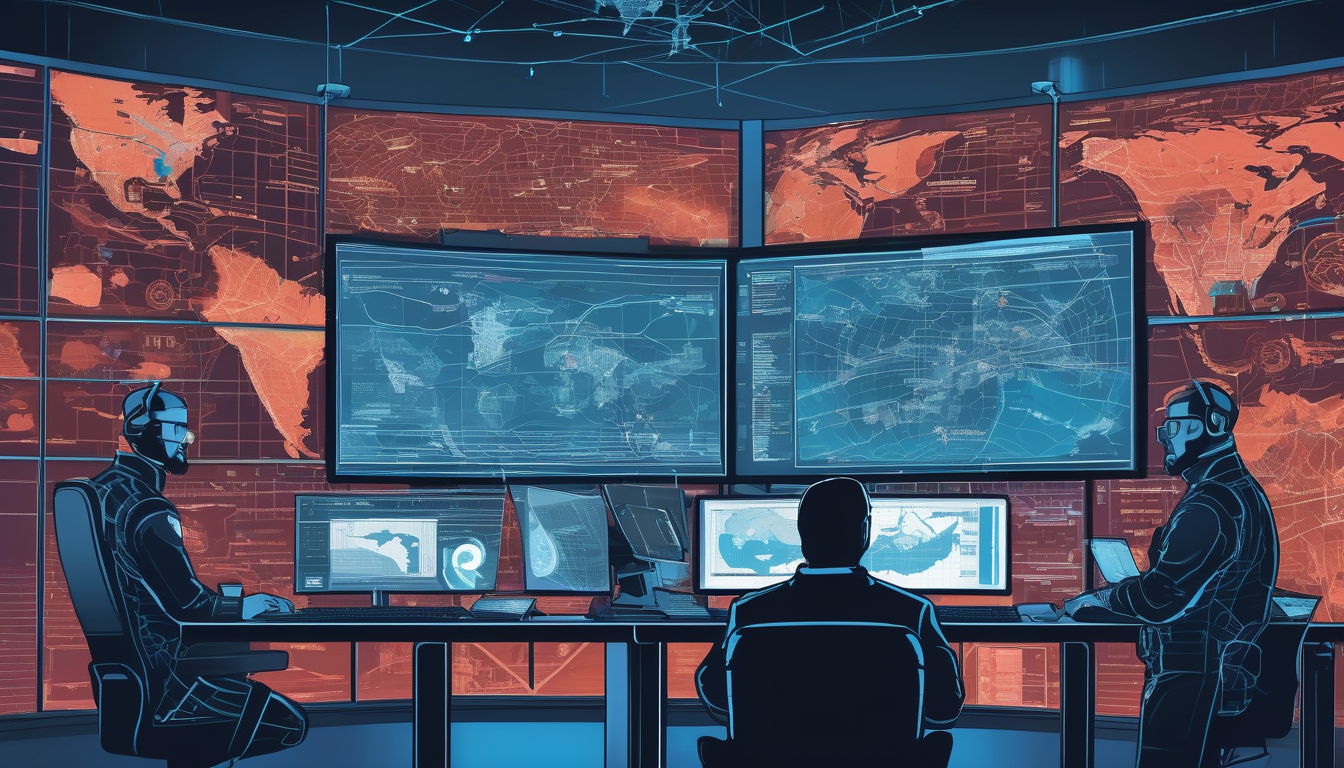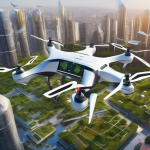The Future of Cyberwarfare: How Nations Are Preparing for Digital Battles

As we plunge deeper into the digital age, the landscape of warfare is undergoing a seismic shift. Cyberwarfare has emerged as a formidable force, reshaping how nations protect their interests and engage in conflicts. Gone are the days when battles were fought solely on land, sea, or air; now, the battleground extends into the virtual realm, where cyber attacks can cripple economies and disrupt societies without a single shot being fired.
The rise of cyberwarfare isn’t just a passing trend; it’s a response to the evolving nature of threats in our interconnected world. With the proliferation of technology comes the potential for exploitation. As countries become increasingly reliant on digital infrastructure, the stakes have never been higher. Imagine a scenario where a nation’s power grid is taken down by a sophisticated cyber attack—chaos would ensue, and the implications would be felt far and wide.
In this new era, nations are not just passive victims; they are actively preparing for digital battles. Governments are investing heavily in cyber defense strategies, recognizing that the ability to protect sensitive information and critical systems is paramount. The question arises: how do they do this? Through a combination of advanced technologies, international cooperation, and public-private partnerships, countries are building resilient defenses to thwart potential attacks.
Moreover, the role of artificial intelligence in cyberwarfare cannot be overstated. AI is revolutionizing both offensive and defensive tactics, enabling faster detection of threats and more effective responses. For example, AI algorithms can analyze vast amounts of data to identify unusual patterns that may indicate a cyber intrusion. This technology is a game-changer, offering nations a significant advantage in the ongoing digital arms race.
As we look to the future, the landscape of cyberwarfare will likely be shaped by emerging technologies and geopolitical trends. Innovations like quantum computing and blockchain could redefine how nations approach cyber operations. With rising tensions between global powers, the strategies employed in cyberspace will be as critical as traditional military tactics. The question remains: are we prepared for the battles that lie ahead in this new digital frontier?

The Rise of Cyberwarfare
The emergence of cyberwarfare as a pivotal element in modern conflicts is nothing short of revolutionary. As we dive into this digital battlefield, it’s crucial to grasp how the landscape has evolved over the years. Historically, wars were fought on physical terrains, but today, the battlefield has shifted to the virtual realm. This transformation has been fueled by the rapid advancement of technology and the increasing reliance on digital infrastructure.
In the early days of the internet, cyber operations were relatively rudimentary, often limited to hacking and basic data breaches. However, as nations recognized the potential of the internet as a weapon, the scope of cyberwarfare began to expand. Today, we are witnessing a surge in sophisticated cyber attacks that can cripple national infrastructures, steal sensitive information, and even manipulate public opinion. The stakes have never been higher!
Several factors have contributed to the rise of cyberwarfare:
- Global Connectivity: With the world more interconnected than ever, a cyber attack can have far-reaching consequences, affecting countries and economies on a global scale.
- Political Tensions: Heightened geopolitical tensions have led nations to explore cyber operations as a means of exerting influence or destabilizing rivals.
- Technological Advancements: The evolution of technology has equipped state and non-state actors with powerful tools that make cyber warfare more accessible and effective.
Moreover, the anonymity provided by the internet allows nations to engage in covert operations without immediate repercussions. This cloak of invisibility has made cyberwarfare an attractive option for states looking to achieve their objectives without the risks associated with traditional military engagements.
As we look to the future, it’s evident that cyberwarfare is not just a passing phase; it is a new reality that nations must navigate. The implications for national security are profound, as governments scramble to bolster their defenses against an ever-evolving array of threats. The rise of cyberwarfare has redefined the rules of engagement in international relations, making it imperative for countries to adapt their strategies to this new digital frontier.

Nation-State Actors
The world of cyberwarfare is increasingly dominated by , who are not just passive participants but rather active players in this digital battlefield. These countries engage in cyber operations for various reasons, making the landscape both complex and dynamic. Have you ever wondered what drives a nation to launch a cyber attack? The motivations are as diverse as they are strategic, often intertwining political, economic, and military objectives.
At the forefront of this digital conflict are major players like the United States, Russia, China, and North Korea. Each of these nations has developed unique capabilities and strategies tailored to their specific goals. For instance, the U.S. often focuses on defensive measures and international cooperation, while Russia may leverage cyber operations to destabilize its adversaries or influence elections. Meanwhile, China is known for its aggressive intellectual property theft and espionage tactics.
Understanding the motivations behind these cyber operations is crucial. Here are some of the primary drivers:
- Political Objectives: Many nation-states aim to destabilize foreign governments or sway elections, using cyber tactics as a modern form of warfare.
- Economic Gains: Cyber attacks can be financially motivated, targeting critical infrastructure or stealing sensitive data to gain an economic edge.
- Military Strategy: Some nations view cyber capabilities as an extension of their military arsenal, using them to prepare for potential conflicts.
As we delve deeper into the motivations of these nation-state actors, it becomes evident that their actions are not merely random acts of aggression but rather calculated moves in a larger game of strategy. The implications of their cyber operations extend beyond immediate effects, influencing global politics and national security. With the stakes so high, the question remains: how will nations adapt to this evolving threat landscape?
In summary, the realm of cyberwarfare is not just about technology but also about the strategic decisions made by nation-states. As these actors continue to refine their tactics, the world must remain vigilant and prepared for the challenges that lie ahead.
Motivations for Cyber Attacks
In the digital age, understanding the is crucial for grasping the complex landscape of cyberwarfare. Nations engage in these operations for a variety of reasons, often intertwining political, economic, and military objectives. Imagine a chess game where each move is calculated not just for immediate gain but for long-term dominance on the board. This analogy holds true in the realm of cyber conflicts, where nations strategize their cyber operations with similar foresight.
At the heart of many cyber attacks lies a desire for political power. Governments may resort to hacking to destabilize opponents, influence elections, or gather intelligence. For instance, consider how a well-timed cyber attack could sway public opinion or disrupt critical governmental functions. Such actions can lead to significant shifts in power dynamics, making the digital battlefield as important as the physical one.
Another driving force behind cyber attacks is the pursuit of economic advantage. Countries may seek to steal intellectual property, disrupt supply chains, or target financial institutions to gain leverage in international trade. The financial stakes involved are staggering; a single breach can lead to billions in losses. This economic warfare is akin to a corporate spy infiltrating a rival firm to steal trade secrets, but on a national scale.
Moreover, military objectives cannot be overlooked. Cyber operations are increasingly seen as an extension of traditional warfare. Nations might engage in cyber attacks to prepare the battlefield, disrupt enemy communications, or gather intelligence ahead of physical confrontations. This evolving strategy highlights the necessity for countries to not only defend their digital infrastructure but also to enhance their offensive capabilities.
In summary, the motivations for cyber attacks are multifaceted, involving a complex interplay of political, economic, and military factors. As nations continue to navigate this digital landscape, understanding these motivations will be key to anticipating future conflicts and developing effective cyber defense strategies.
Political Objectives
In the realm of cyberwarfare, political objectives often serve as the driving force behind state-sponsored cyber attacks. These operations are not just about breaching firewalls; they are strategic maneuvers aimed at altering the balance of power on the global stage. Imagine a game of chess, where each move is calculated to destabilize an opponent’s position, influence public opinion, or sway electoral outcomes. This is the essence of political cyber operations.
Countries leverage cyber capabilities to achieve a variety of political goals, including:
- Destabilizing Governments: Cyber attacks can undermine the stability of a government by disrupting essential services or leaking sensitive information that erodes public trust.
- Influencing Elections: By manipulating social media platforms or hacking electoral systems, state actors can sway public sentiment and impact electoral outcomes, as seen in recent global events.
- Promoting Propaganda: Cyber tools are utilized to spread disinformation, shaping narratives that benefit the attacking nation while discrediting opponents.
For instance, the infamous Russian interference in the 2016 U.S. presidential election showcased how cyber capabilities can be wielded to achieve significant political influence. By deploying a mix of hacking and social media manipulation, the attackers aimed to create division and chaos, ultimately impacting the democratic process.
Moreover, the landscape of cyberwarfare is constantly evolving, with nations continuously refining their strategies to exploit vulnerabilities in their adversaries’ political systems. As countries enhance their cyber capabilities, the potential for politically motivated cyber attacks increases, making it imperative for nations to bolster their defenses and develop counter-strategies.
In conclusion, the political objectives behind cyber attacks highlight the strategic importance of digital operations in contemporary geopolitics. As nations prepare for future conflicts, understanding these motivations is crucial for developing effective defense mechanisms and maintaining national security.
Economic Gains
The world of cyberwarfare isn’t just about political power; it’s also a battlefield for economic supremacy. Nations are increasingly leveraging cyber attacks to achieve significant financial benefits, making the stakes higher than ever. Think of it as a digital gold rush where the treasure isn’t gold, but intellectual property, trade secrets, and sensitive data.
One of the primary motivations behind state-sponsored cyber attacks is the theft of intellectual property. This includes valuable research and development data, proprietary technology, and innovative ideas that can give a country or corporation a competitive edge. For instance, when a nation hacks into a tech company to steal cutting-edge software designs, it can leapfrog ahead in technological advancements without the hefty investment in research.
Moreover, cyber attacks can disrupt critical infrastructure, causing economic chaos that can benefit the aggressor. Imagine a scenario where a country targets another’s power grid or financial systems, leading to widespread outages or financial turmoil. The resulting instability can create opportunities for the attacking nation to swoop in and fill the void, whether through economic aid or by establishing favorable trade agreements.
To illustrate the economic implications of cyberwarfare, consider the following table:
| Type of Economic Gain | Description |
|---|---|
| Theft of Intellectual Property | Acquiring trade secrets and technology to enhance national industries. |
| Disruption of Competitors | Causing chaos in rival nations’ economies to weaken their global standing. |
| Financial Espionage | Gaining access to sensitive financial information for strategic advantage. |
In conclusion, as nations ramp up their cyber capabilities, the pursuit of economic gains will remain a driving force behind cyber warfare. With the potential for massive financial rewards, countries are not just fighting for survival; they are battling for economic dominance in an increasingly interconnected world. The implications of this new form of warfare extend beyond immediate financial gain, potentially reshaping global economic landscapes for years to come.
Technological Advancements
The landscape of cyberwarfare is constantly evolving, driven by rapid . As nations gear up for potential digital battles, the tools and tactics they employ are becoming increasingly sophisticated. From artificial intelligence to blockchain technology, these innovations are reshaping the way conflicts are fought in cyberspace.
One of the most significant developments is the integration of artificial intelligence (AI) into both offensive and defensive operations. AI systems can analyze vast amounts of data at lightning speed, allowing for quicker decision-making and more effective strategies. For example, AI algorithms can identify vulnerabilities in a target’s system or predict potential attack vectors by analyzing patterns of behavior. This capability not only enhances the effectiveness of cyber attacks but also improves defensive measures by enabling real-time threat detection.
Another key technological advancement is the rise of quantum computing. This cutting-edge technology promises to revolutionize data processing and encryption, making traditional cybersecurity measures potentially obsolete. With quantum computers, attackers could break encryption codes that were previously considered secure, posing a significant threat to national security. On the flip side, nations are also exploring quantum cryptography as a means to protect sensitive information, creating a new arms race in the digital domain.
Moreover, advancements in blockchain technology are providing innovative solutions for securing communications and transactions. By decentralizing data storage, blockchain can reduce the risk of data breaches, making it a valuable asset for both attackers and defenders. Countries are beginning to recognize the potential of blockchain not just for financial transactions, but as a foundational technology for secure communications in cyberwarfare.
In summary, as technology continues to advance, the methods and strategies employed in cyberwarfare will also evolve. Nations must stay ahead of the curve by investing in research and development to harness these technological innovations. The future of digital battles will depend on who can effectively leverage these tools to gain a strategic advantage. With the stakes higher than ever, the race for technological supremacy in cyberspace is on.

Cyber Defense Strategies
As cyber threats continue to evolve, nations around the world are stepping up their game in the realm of . The stakes are incredibly high—imagine a world where critical infrastructure can be compromised at the click of a button. To combat this reality, countries are not just relying on traditional military might; they are investing heavily in advanced technologies and collaborative efforts. The focus is on creating a resilient digital environment that can withstand potential attacks.
One of the pivotal aspects of modern cyber defense is the establishment of public-private partnerships. These collaborations bring together the expertise of government agencies and the innovative capabilities of private sector companies. By pooling resources and knowledge, they can enhance cybersecurity measures significantly. For instance, tech companies can provide cutting-edge tools while government entities can share threat intelligence. This synergy is crucial for developing comprehensive defense frameworks, as illustrated in the table below:
| Partnership Type | Description | Benefits |
|---|---|---|
| Government Agencies | Entities responsible for national security. | Access to classified information and resources. |
| Private Sector | Companies providing technology solutions. | Innovative tools and rapid response capabilities. |
| Academic Institutions | Research organizations focused on cybersecurity. | Cutting-edge research and workforce development. |
Moreover, international cooperation is becoming increasingly important. Countries are working together to establish international cyber agreements that set norms for acceptable behavior in cyberspace. These agreements aim to mitigate risks and foster a sense of accountability among nations. Without such frameworks, the potential for misunderstandings and escalations in cyber conflicts could be disastrous.
As we look to the future, it’s clear that the landscape of cyber defense will continue to evolve. Nations must remain vigilant, adapting to new threats and leveraging emerging technologies. The combination of public-private partnerships and international agreements will be essential in building a robust defense against the ever-present dangers of cyberwarfare.
Public-Private Partnerships
In the ever-evolving landscape of cybersecurity, the collaboration between government entities and private companies has emerged as a crucial strategy for enhancing national security. These are not just buzzwords; they represent a fundamental shift in how nations approach cyber defense. By pooling resources, expertise, and technology, both sectors can create a more resilient digital infrastructure capable of withstanding the growing threats posed by cyber adversaries.
Why are these partnerships so essential? Well, consider this: government agencies often lack the agility and cutting-edge technology that private companies possess. On the other hand, private firms may not fully understand the complex regulatory environment that governments operate within. This is where collaboration comes into play, enabling a fusion of strengths to tackle cyber threats effectively.
For instance, a recent initiative in the United States has seen the Department of Homeland Security partnering with tech giants like Microsoft and Google to develop advanced threat detection systems. These systems leverage artificial intelligence and machine learning to identify vulnerabilities in real-time, enabling quicker responses to potential attacks. This partnership exemplifies how leveraging private sector innovation can significantly bolster national security.
Moreover, these collaborations often extend beyond technology sharing. They also involve information exchange regarding threats and vulnerabilities. By creating platforms where both sectors can communicate openly, they enhance the collective understanding of the cyber threat landscape. This exchange of intelligence can be vital in preemptively identifying and mitigating potential attacks.
However, establishing these partnerships is not without challenges. Issues such as data privacy, regulatory compliance, and differing objectives can complicate collaboration efforts. To address these challenges, many countries are working on frameworks that define the roles and responsibilities of each party involved. For example:
| Challenge | Solution |
|---|---|
| Data Privacy | Implementing strict data governance policies |
| Regulatory Compliance | Creating standardized guidelines for partnerships |
| Differing Objectives | Establishing clear communication channels |
In conclusion, public-private partnerships are becoming indispensable in the realm of cybersecurity. They not only enhance the capabilities of both sectors but also create a united front against the ever-present threat of cyberwarfare. As nations continue to navigate this digital battlefield, the strength of these collaborations will undoubtedly play a pivotal role in shaping the future of national security.
International Cyber Agreements
The landscape of cyberwarfare is not just a battlefield of ones and zeros; it’s also a complex arena where international relations play a pivotal role. As nations increasingly turn to digital means to achieve their objectives, the need for has never been more pressing. These agreements aim to establish norms and guidelines that govern state behavior in cyberspace, much like treaties that regulate traditional warfare.
One of the primary goals of these agreements is to mitigate the risks of cyber conflicts. By setting clear expectations for acceptable conduct, nations can work towards reducing misunderstandings that might escalate into full-blown cyber warfare. For instance, agreements can outline what constitutes a cyber attack and define the thresholds for retaliation. This is crucial because, in the digital realm, the line between offensive and defensive actions can often be blurred.
Moreover, international cyber agreements foster cooperation and information sharing among nations. In a world where cyber threats know no borders, collaboration is essential. Countries can benefit from sharing intelligence on emerging threats and vulnerabilities, which can enhance their collective security posture. For example, the Budapest Convention on Cybercrime serves as a framework for international cooperation, enabling law enforcement agencies to work together more effectively against cybercrime.
However, creating these agreements is a complex process. Nations must navigate a myriad of political, economic, and cultural differences. The challenge lies in finding common ground while respecting each nation’s sovereignty. As discussions progress, it’s crucial for nations to consider the implications of their agreements on national security and individual rights. Balancing these interests can be tricky, but it’s essential for the success of any international accord.
In conclusion, as cyberwarfare continues to evolve, so too must our approaches to managing it. International cyber agreements represent a critical step in this direction, providing a framework for cooperation and conflict resolution. As nations work together to establish these norms, they pave the way for a more secure digital future. The road ahead may be fraught with challenges, but the potential for a safer cyberspace is worth the effort.

The Role of Artificial Intelligence
Artificial Intelligence (AI) is not just a buzzword; it is a game-changer in the realm of cyberwarfare. As nations gear up for potential digital conflicts, AI technologies are being integrated into both offensive and defensive strategies, reshaping the battlefield in profound ways. Imagine AI as the brain behind a highly sophisticated chess game, where each move is calculated, and every decision is backed by vast amounts of data.
On the offensive side, AI enables attackers to enhance their strategies significantly. For example, automated systems can analyze vulnerabilities in a target’s infrastructure at lightning speed, identifying weak points that human hackers might overlook. This capability is akin to having a super-intelligent scout who can gather intelligence and suggest the most effective routes for attack. Moreover, AI can facilitate phishing attacks by crafting highly personalized messages that are more likely to deceive recipients, making the cyber landscape even more perilous.
Conversely, AI is equally critical in bolstering cyber defense. With the ever-increasing volume of cyber threats, traditional defense mechanisms struggle to keep pace. AI-powered systems can monitor network traffic in real time, identifying anomalies that could indicate a breach. This is like having a vigilant security guard who never sleeps, constantly watching for suspicious activity. Additionally, machine learning algorithms can improve their detection capabilities over time, learning from past incidents to enhance future responses.
The integration of AI in cyber operations raises important questions about the future of warfare. As these technologies evolve, so too will the tactics employed by state actors. Nations must not only invest in AI for their own defense but also consider the implications of adversaries wielding similar technologies. This arms race in AI could lead to a new era of digital warfare, where speed and intelligence become the primary determinants of success.
In summary, the role of AI in cyberwarfare is multifaceted and dynamic. It is transforming how nations prepare for and engage in digital conflicts, making it essential for governments to stay ahead of the curve. As we move forward, understanding the implications of AI in this context will be crucial for national security and global stability.
AI in Offensive Operations
Artificial Intelligence (AI) is revolutionizing the landscape of offensive cyber operations, transforming traditional tactics into sophisticated strategies that are both effective and unpredictable. Imagine a chess game where your opponent not only anticipates your moves but also evolves its strategy in real-time based on your play. This is the essence of AI in cyber warfare, where algorithms can analyze vast amounts of data to identify vulnerabilities and exploit them with precision.
One of the most significant advancements is the ability of AI systems to automate attacks. This means that cyber adversaries can execute complex operations at a speed and scale that human operators simply cannot match. For instance, AI can be programmed to launch phishing attacks that are tailored to individual targets, increasing the likelihood of success. By analyzing social media profiles and online behavior, these systems can craft messages that appear remarkably genuine, making it difficult for individuals to discern the threat.
Moreover, AI can enhance the effectiveness of malware. Traditional malware often relies on known signatures to be detected, but AI-driven malware can adapt its behavior based on the environment it infiltrates. This adaptability allows it to evade detection systems, making it a formidable weapon in the arsenal of cyber attackers. The implications are staggering: as AI continues to advance, we may see a rise in autonomous cyber weapons capable of launching attacks without direct human intervention.
To illustrate the potential impact of AI in offensive operations, consider the following table:
| AI Application | Description |
|---|---|
| Automated Phishing | Crafting personalized phishing emails based on target data. |
| Adaptive Malware | Malware that changes its code to avoid detection. |
| Data Mining | Analyzing large datasets to identify potential vulnerabilities. |
In summary, the integration of AI into offensive cyber operations is not just a trend; it’s a game-changer. As nations ramp up their cyber capabilities, the race to harness AI for offensive purposes will only intensify. The future of digital warfare is not just about who has the best technology, but also about who can outsmart their adversaries in the ever-evolving battlefield of cyberspace.
AI in Cyber Defense
In the ever-evolving landscape of cyber threats, artificial intelligence (AI) is emerging as a game changer for national security. Imagine having a digital guardian that never sleeps, constantly monitoring and analyzing vast amounts of data to detect potential threats before they escalate into full-blown attacks. This is precisely what AI brings to the table in cyber defense.
One of the most significant advantages of AI in cyber defense is its ability to process and analyze data at lightning speed. Traditional methods often rely on human analysts who can become overwhelmed by the sheer volume of information. AI, on the other hand, can sift through terabytes of data in seconds, identifying patterns and anomalies that might go unnoticed by human eyes. This capability is crucial in a world where cyber threats are becoming increasingly sophisticated.
Furthermore, AI enhances threat detection through machine learning algorithms that continuously adapt and improve. These algorithms can learn from past incidents and adjust their parameters to better identify new threats. For instance, if a particular type of malware is detected, the AI system can update its detection methods, ensuring that it remains effective against evolving attack strategies.
AI also plays a pivotal role in incident response. When a cyber attack is detected, AI systems can automate responses, significantly reducing the time it takes to mitigate damage. This rapid response capability is vital, as every second counts when dealing with a cyber incident. By automating routine tasks, cybersecurity teams can focus on more complex issues, improving overall efficiency.
To illustrate the impact of AI in cyber defense, consider the following table that outlines key capabilities:
| Capability | Description |
|---|---|
| Real-Time Monitoring | Constantly analyzes network traffic for suspicious activity. |
| Threat Prediction | Utilizes historical data to forecast potential attacks. |
| Automated Response | Quickly implements predefined actions to neutralize threats. |
| Adaptive Learning | Improves detection accuracy by learning from new threats. |
As we look to the future, the integration of AI in cyber defense will only deepen. With the rise of smart technologies and the Internet of Things (IoT), the potential attack surface expands, making AI’s role even more critical. It’s not just about keeping up; it’s about staying one step ahead in the digital arms race.

The Future Landscape of Cyberwarfare
The future of cyberwarfare is poised to be an exhilarating yet daunting domain, where the lines between physical and digital battles blur. As nations gear up for potential conflicts, the integration of cutting-edge technologies will redefine how these digital skirmishes unfold. Imagine a chess game where every piece is a complex algorithm, constantly evolving and adapting to the opponent’s moves. This is the new reality of cyber warfare.
One of the most significant influences on the future landscape of cyberwarfare will be emerging technologies. Technologies like quantum computing and blockchain are not just buzzwords; they hold the potential to revolutionize both offensive and defensive strategies. Quantum computing, for instance, could enable attackers to crack encryption methods that were once thought to be unbreakable, while defenders may leverage its capabilities to enhance data security and integrity.
Moreover, the geopolitical climate will continue to play a crucial role in shaping cyber warfare strategies. With rising tensions among global powers, nations are increasingly viewing cyber operations as essential tools for achieving their geopolitical objectives. The stakes are high, and the consequences of cyber conflicts can ripple through economies and societies. Countries will need to remain vigilant and proactive, adapting their strategies in response to shifting alliances and emerging threats.
In this evolving landscape, we can expect to see a few key trends:
- Increased Investment in Cybersecurity: Nations will funnel more resources into strengthening their digital defenses, recognizing that a robust cybersecurity posture is critical for national security.
- Collaboration Across Borders: As cyber threats know no borders, international partnerships will become paramount. Countries will need to work together to establish norms and guidelines for acceptable behavior in cyberspace.
- AI and Automation: The integration of artificial intelligence in both offensive and defensive operations will become more prevalent, enhancing the speed and effectiveness of cyber strategies.
As we look ahead, it’s clear that the future of cyberwarfare will be marked by complexity and unpredictability. Just like a storm brewing on the horizon, the digital battlefield is evolving rapidly, and nations must prepare for the unexpected. The question remains: are we ready for the digital storms that lie ahead?
Emerging Technologies
The world of cyberwarfare is rapidly evolving, and at the heart of this transformation are that promise to reshape how nations engage in digital conflicts. Technologies like quantum computing and blockchain are not just buzzwords; they are game-changers that can redefine the rules of engagement in cyberspace.
To understand the implications of these technologies, let’s first dive into quantum computing. This revolutionary technology has the potential to break traditional encryption methods, making current cybersecurity measures obsolete. Imagine a future where sensitive data, once considered secure, is easily accessible to adversaries equipped with quantum computers. This scenario raises urgent questions about how nations will protect their digital assets. Countries are already investing heavily in quantum research, and the race to achieve quantum supremacy is on. The stakes are incredibly high, and the implications for national security are profound.
On the other hand, blockchain technology offers a different kind of promise. Known primarily for its role in cryptocurrency, blockchain’s decentralized nature can enhance cybersecurity by providing a transparent and immutable ledger. This means that any attempt to alter data becomes easily detectable, making it an attractive option for securing sensitive information. Governments are beginning to explore how blockchain can be integrated into their cybersecurity frameworks to create more resilient systems.
Furthermore, the integration of these technologies is not just theoretical. For instance, some nations are already piloting blockchain-based voting systems to ensure election integrity, while others are exploring quantum encryption methods for secure communications. The potential for collaboration between these technologies could lead to even more robust defense mechanisms against cyber threats.
However, with these advancements come significant challenges. As nations race to adopt these technologies, the digital divide may widen, creating disparities between nations with advanced capabilities and those without. This could lead to new forms of conflict, as nations with superior technology may feel emboldened to engage in more aggressive cyber operations.
In conclusion, the future of cyberwarfare will be heavily influenced by these emerging technologies. As nations prepare for the digital battleground, understanding and leveraging these advancements will be crucial for maintaining national security. The question remains: will these technologies be used to protect or to attack?
Geopolitical Trends
The landscape of cyberwarfare is not just a result of technological advancements; it’s deeply intertwined with the shifting dynamics of global politics. As nations grapple with the implications of digital conflicts, several are emerging that will likely shape the future of cyber engagements. One major trend is the increasing tension between superpowers. Countries like the United States, China, and Russia are not only enhancing their military capabilities but are also investing heavily in cyber capabilities to assert dominance on the global stage.
Moreover, the rise of non-state actors is complicating this landscape. Hacktivist groups, cybercriminals, and other non-governmental entities are increasingly playing pivotal roles in cyber conflicts, often acting as proxies for state interests. This blurring of lines between state and non-state actors adds a layer of complexity to traditional geopolitical strategies, making it harder for nations to respond effectively.
Another significant trend is the regional conflicts spilling into the digital realm. As tensions rise in areas like the South China Sea or Eastern Europe, cyber operations are becoming a tool for nations to exert pressure without resorting to conventional warfare. For instance, recent cyber attacks on critical infrastructure in various countries have highlighted how digital warfare can serve as a means of political leverage.
To illustrate these trends, consider the following table that summarizes key geopolitical factors influencing cyberwarfare:
| Geopolitical Factor | Description |
|---|---|
| Superpower Rivalry | Intensifying competition among major nations, leading to increased cyber activities as tools of influence. |
| Non-State Actors | Emergence of groups that operate independently, often complicating state responses and strategies. |
| Regional Conflicts | Localized tensions that escalate into cyber operations, serving as a form of indirect confrontation. |
As we look to the future, understanding these is critical for nations aiming to navigate the complex waters of cyberwarfare. The strategies they adopt will not only impact their own security but also the global balance of power in the digital age.
Frequently Asked Questions
- What is cyberwarfare?
Cyberwarfare refers to the use of digital attacks by one nation to disrupt the vital computer systems of another, often with the aim of causing damage or disruption to critical infrastructure.
- Why are nation-states engaging in cyber operations?
Nation-states engage in cyber operations for various reasons, including political objectives like destabilizing governments, economic gains such as stealing intellectual property, and military advantages to gain leverage in conflicts.
- How does artificial intelligence impact cyberwarfare?
Artificial intelligence is revolutionizing cyberwarfare by enhancing both offensive and defensive strategies. Attackers use AI to automate and improve attack effectiveness, while defenders leverage AI for advanced threat detection and rapid response.
- What are public-private partnerships in cybersecurity?
Public-private partnerships involve collaboration between government entities and private companies to strengthen cybersecurity. These partnerships are crucial for sharing intelligence, resources, and best practices to enhance national security.
- What emerging technologies are influencing cyberwarfare?
Emerging technologies like quantum computing and blockchain are expected to significantly alter the landscape of cyberwarfare. Quantum computing could break current encryption methods, while blockchain offers new ways to secure data and transactions.
- How are international agreements shaping cyber conduct?
International agreements aim to establish norms and guidelines for state behavior in cyberspace. These agreements are essential for reducing the risk of conflict and promoting responsible state conduct in digital environments.













